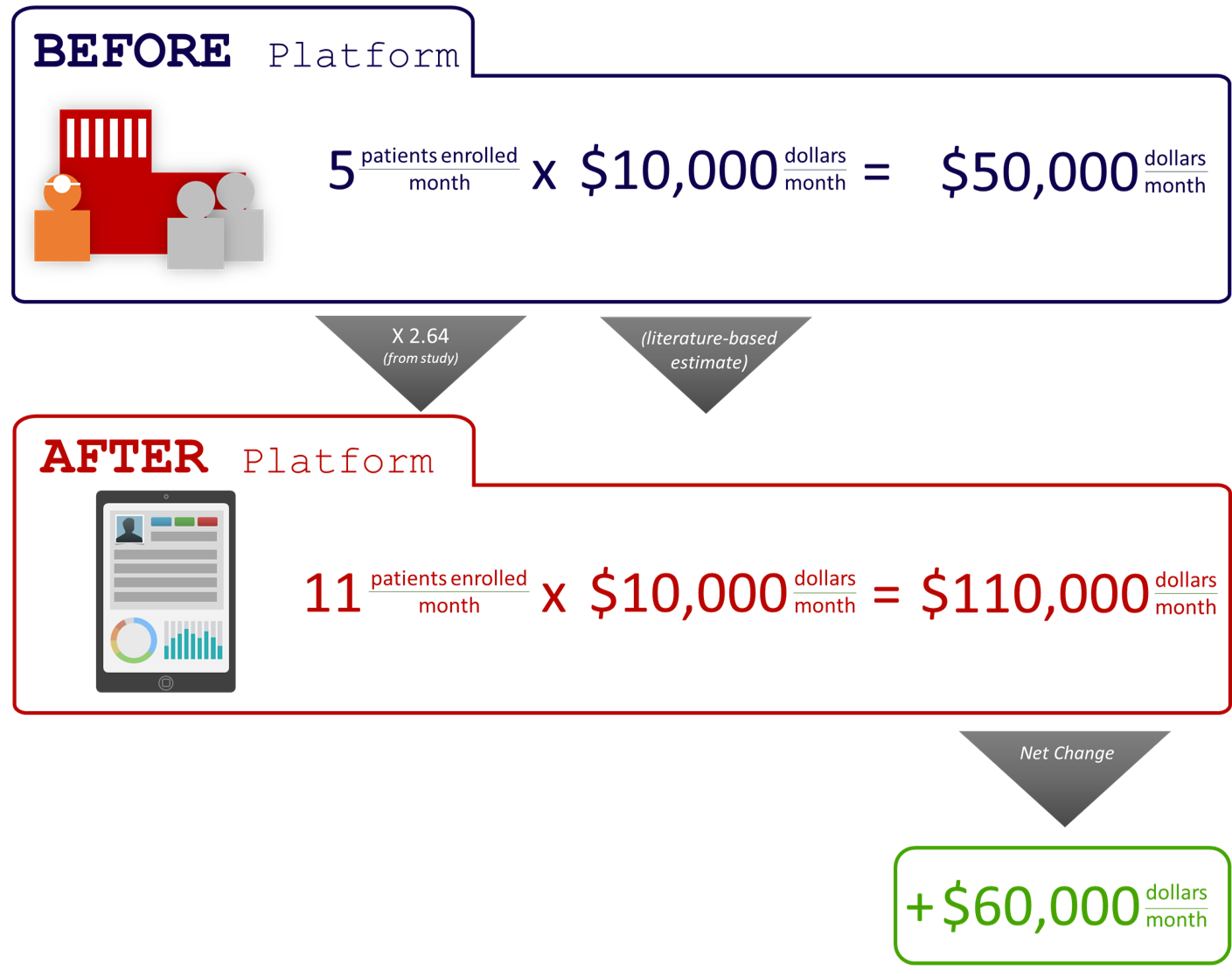It doesn’t have to be complicated to prove value in healthcare.
Below, you will learn a simple 2-step formula you can start using today to dramatically boost your bottom line.
I recently came across a HUGE opportunity for a healthcare upstart to sell a lot more of their product.
The opportunity was based on something so small, it was easy to miss.
In fact, it was based on a single data point.
And while the CEO of the company understood the data highlighted something valuable, she had no idea just HOW valuable.
As an expert in proving value, I see missed opportunities like this all the time.
Healthcare providers and executives are so busy seeing patients and running their core businesses, they don’t have time to think about using their data in novel ways that prove their value.
Furthermore, many of the best leaders in healthcare have clinical training and background. That makes them excellent with what matters most – patient care – but less sensitive to the marketing opportunities that sit right in front of them.
That’s why I wrote this article… to help you see just how easy it can be to take data you already have and turn it into additional revenue.
I hope that by highlighting what is possible with a single data point, you’ll start seeing similar opportunities within your own healthcare business.
So let’s get started…
Ingredients to Prove Value in Healthcare
In order to prove value in healthcare, you need the right ingredients.
Since healthcare businesses are founded on science, that means data!
Most would agree, there’s no shortage of data in medicine.
But which is the right set of ingredients, or single ingredient, to highlight the value of your healthcare service or product?
For our case study, I happened to come across a single data point with BIG potential.
As background, the company’s product is an electronic tablet based platform that addresses potential barriers to cancer clinical trial participation. Their customer is the researcher (individual or within an institution), who is generally always looking to enroll more patients in trials which they oversee. Unfortunately, many qualified candidates choose not to enroll in clinical trials for reasons that range from lack of awareness to fear.
Wisely, the company worked with an academic research center to evaluate the effectiveness of their platform.
And guess what they found?
They showed that the patient enrollment rate moved from 13.8% to 36.4%. That’s a 264% increase!
Clinically, everyone in cancer care realizes this is a good thing. More patients in clinical trials means studies enroll faster and complete faster. That means safe and effective treatments get to market faster. The war on cancer makes forward progress.
That’s the clinical story.
But let’s consider this data through a different lens? What does it look like from the perspective of the marketer?
Quite simply, this piece of data is a marketing gold mine!
That’s because it conforms to a classic effective marketing formula – it paints the proverbial “before” and “after” pictures.
You see, the institution enrollment rate jumped from 13.8% before use of the platform to 36.4% after using the system. This gives potential customers a quantified, data-driven picture of exactly what benefit they can expect by purchasing the platform.
While these numbers alone may be enough to convince some customers of the value of the platform, there is a simple way to turn the decision into a no-brainer.
Translating Clinical Benefit into Economic Benefit
As described above, there is now a proven clinical benefit of the electronic platform.
Potential customers for the product may or may not understand the value in increasing clinical trial enrollment to their own research business.
Either way, we are relying on them to do the mental calculations that translate the clinical benefit into economic benefit.
There is nothing wrong with that…
… but every great marketer knows it is best to handle as much of the thinking as possible when promoting a product.
As such, our opportunity is to handle the translation from clinical to economic benefit for them. Of course, they’ll be free to create their own assessment by adjusting the numbers to fit their own circumstance, but we want to at least give them a starting point (i.e., a baseline calculation).
In our case, we only need one additional input for the translation – the dollar value of enrolling a patient in a clinical trial.
Of course, this figure changes from study to study and from institution to institution. But we just need to find some sort of average number for our baseline estimate.
After a bit of research, I was able to find out that many trial sponsors (e.g., drug companies) pay research sites on a per capita basis. This means that the research site is paid a dollar fee for each patient it enrolls. Typically, this fee is around $10,000 per enrolled patient.1 Hall MA, et al. Commentary: Per Capita Payments in Clinical Trials: Reasonable Costs Versus Bounty Hunting. Acad Med. 2010;85:1554 –1556,2 Seton Hall University School of Law. Conflicts of interest in clinical trial recruitment & enrollment: a call for increased oversight. Available … Continue reading
Now we just need to do some very simple math that highlights the value of our product.
Let’s assume our hypothetical research site averages enrolling 5 patients per month in clinical trials. Based on our clinical data point – a 264% increase in the number of total patient enrolled – and our literature-based estimate for the value of each patient enrolled (i.e., $10,000 per patient) – we can demonstrate a before an after scenario for our given research site.

That’s a $60,000 per month incremental gain. Even if the product cost the research site $6,000 per month, it’s a 10:1 ROI for the customer. Not many customers will shake their fist at a 10:1 ROI 🙂
Wrap Up: A Simple Way to Prove Value in Healthcare
Opportunities to prove value in healthcare products and services surround us.
At the same time, these opportunities are frequently missed. That’s because healthcare providers and executives are very busy seeing patients and running their core businesses.
Also, they are generally trained clinicians and don’t always see the marketing potential of what sits right in front of them.
In this article, you have seen how a simple 2-step process can dramatically improve your bottom line:
- identify a data point highlighting a clinical benefit
- translate the data into an economic benefit
I hope this simple example helps you see just how easy it can be to identify, quantify and package your own data into a compelling value proposition. One that supports greater utilization of the valuable healthcare services and products you offer.
I’d love to hear how you have been able to use your own data to prove value in healthcare. Contact me.
References
| 1 | Hall MA, et al. Commentary: Per Capita Payments in Clinical Trials: Reasonable Costs Versus Bounty Hunting. Acad Med. 2010;85:1554 –1556 |
|---|---|
| 2 | Seton Hall University School of Law. Conflicts of interest in clinical trial recruitment & enrollment: a call for increased oversight. Available at: https://law.shu.edu/Health-Law/upload/health_center_whitepaper_nov2009.pdf. Accessed May 2016 |
